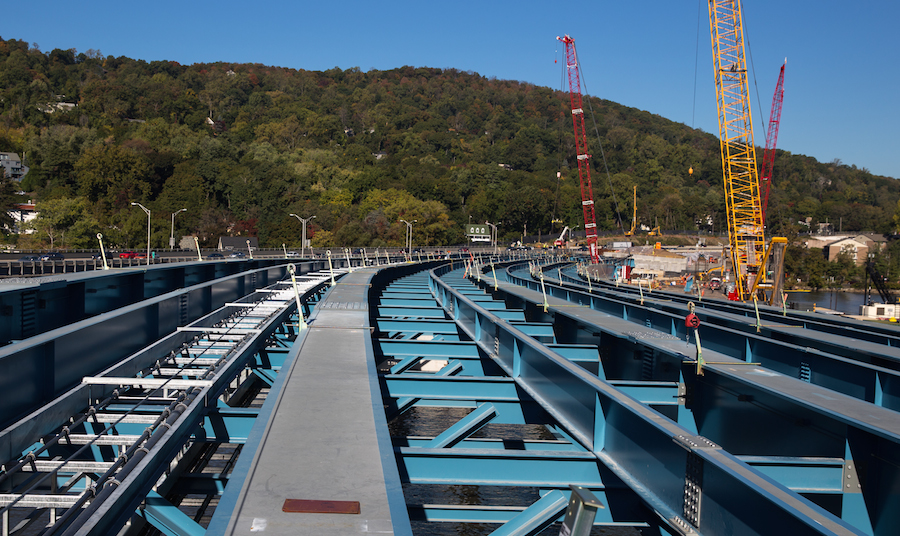Obama Signs $305B, Five-Year Transport Measure

The extended search for a long-term transportation bill is over, as President Obama has signed into law a measure authorizing $305 billion over five years for highway, transit and Amtrak programs. It is the first transportation legislation of that length to go on the books since 2005.
The measure, which Obama signed on Dec. 4, won final congressional approval the night before, when the Senate passed it by an 83-16 vote. The House had cleared it earlier, on Dec. 3, on a 359-65 vote.
The enactment came shortly before the latest in a series of short stopgap measures was to expire.
According to ENR’s calculations, the new bill—the Fixing America’s Surface Transportation Act (FAST)—authorizes about $230 billion for highways, $61 billion for public transit, $10 billion for Amtrak and $5 billion for highway safety programs.
The top negotiators—House Transportation and Infrastructure Committee Chairman Bill Shuster (R-Pa.), Senate Environment and Public Works Committee Chairman James Inhofe (R-Okla.), Sen. Barbara Boxer (D-Calif.) and Rep. Peter DeFazio (D-Ore.)—worked to reconcile differences between nominally six-year bills that each chamber had approved earlier this year. The Senate version was estimated at $350 billion; the House bill authorized $335-billion plus.
The four legislators announced on Dec. 1 that they had struck a deal, saying in a joint statement, “This conference report provides long-term certainty for states and local governments and good reforms and improvements to the programs that sustain our roads, bridges, transit and passenger-rail system.”
Boxer—who called the bipartisan legislative effort "the impossible dream" and "The Perils of Pauline"—noted that, in the legislation’s first year, fiscal 2016, it would hike highway funding by 5% and public transit funding by 8%. ENR calculates that annual highway obligations in the bill’s last four years would rise by an average of 2.3%.
Stephen Sandherr, Associated General Contractors of America CEO, said in a statement that the FAST Act has a “slight boost” in funding but added that the increase “will help cut traffic, improve transportation safety and keep our economy globally competitive.”
Boxer also pointed to two new freight transportation programs in the bill, including one for “nationally significant” freight and highway projects, authorized at $4.5 billion over five years.
Moreover, the conference agreement reauthorizes the 17-year-old Transportation Infrastructure Finance and Innovation Act (TIFIA) federal loan program—an important component of many major projects’ financing—at $1.1 billion over five years. But that amount is well below the $1.75 billion that TIFIA got over 27 months in the last multiyear bill, 2012’s MAP-21.
AGC’s Sandherr notes that the measure also includes policy changes that “will help reduce the amount of time and money it takes to plan, approve and construct new transportation projects.” For example, the bill has language that aims to speed up projects’ environmental reviews. North America's Building Trades Unions pointed to language to expedite project permitting as a particular positive of the new legislation.
State and local transportation officials—and engineering and construction firms that carry out highway and transit infrastructure projects—are pleased and relieved the FAST Act will last for five years.
They have had to operate under five short extensions over the past 14 months and 10 others between September 2010 and July 2012. State highway leaders have said such stopgap funding has hampered their ability to plan long-range projects. Some even cut back on projects because of the federal funding uncertainty.
Alison Black, American Road & Transportation Builders Association chief economist, said in a Dec. 2 webinar that, in the past year, at least 28 states said they planned to delay or have canceled projects.
Michael Melaniphy, American Public Transportation Association CEO, in a statement noted, “As the first long-term surface transportation bill in 10 years, the significance of this legislation cannot be overstated.”
Jay Farrar, manager of Bechtel's Washington, D.C., office, expects that, because of the new legislation, new projects will begin to flow soon. He says, "As the new year starts, in the first quarter, I think you're going to see these things start to break loose."
In addition, the agreement would reauthorize the U.S. Export-Import Bank through fiscal 2019.
Shuster, Inhofe, Boxer and DeFazio also said the measure is “fully paid for”—or revenue-neutral.
Conferees supplemented the weakened Highway Trust Fund’s projected revenue by transferring to it $70 billion from the general fund. That amount is a larger shift than in either the House- or Senate-passed measures.
Speaking to reporters after the House vote, Shuster noted that the conferees did "go higher" in additional funds than the earlier House or Senate bills did. "We got what we could get," he said.
The bill’s drafters offset that $70 billion general-fund reduction through a collection of revenue-raising “pay-fors.” They include customs services fees, liquidating part of the Federal Reserve’s surplus account, reducing the dividends that the Fed pays to banks with assets above $10 billion and selling some of the Strategic Petroleum Reserve’s inventory.
Shuster says some Republicans voted against the bill because they didn't like some of the pay-fors. He adds, "I don't think that's the best solution for the pay-fors. I think it needs to be a user-fee base. But, in this case, we needed this bill to pass, so the majority of our conference thought that this is a way forward."
Asked why Congress seemed to see more need this year to produce a longer-term bill, Shuster says, "In our conference, there was a will to move forward. Overwhelmingly, people said, "We've got to get this done.'"
DeFazio says another factor was that transportation groups kept emphasizing that "these short-term patches aren't working." He adds, "That message was delivered to every member of Congress many times over by many different interests."
U.S. Transportation Secretary Anthony Foxx, who had urged lawmakers to include the largest amount of annual funding possible, said in a statement that "it has been a long and bumpy ride to a long-term transportation bill." Foxx added, "It's not perfect, and there is still more left to do, but it reflects a bipartisan compromise I always knew was possible."
(Story updated on 12/4/2015 with bill enactment.)



